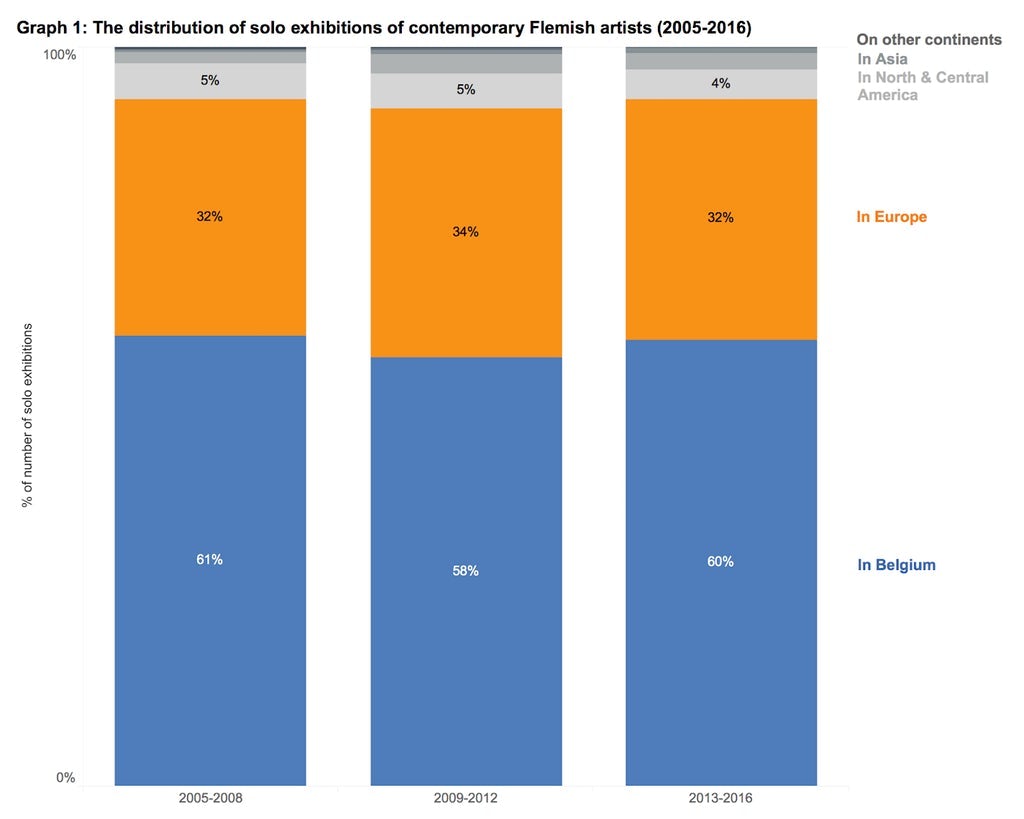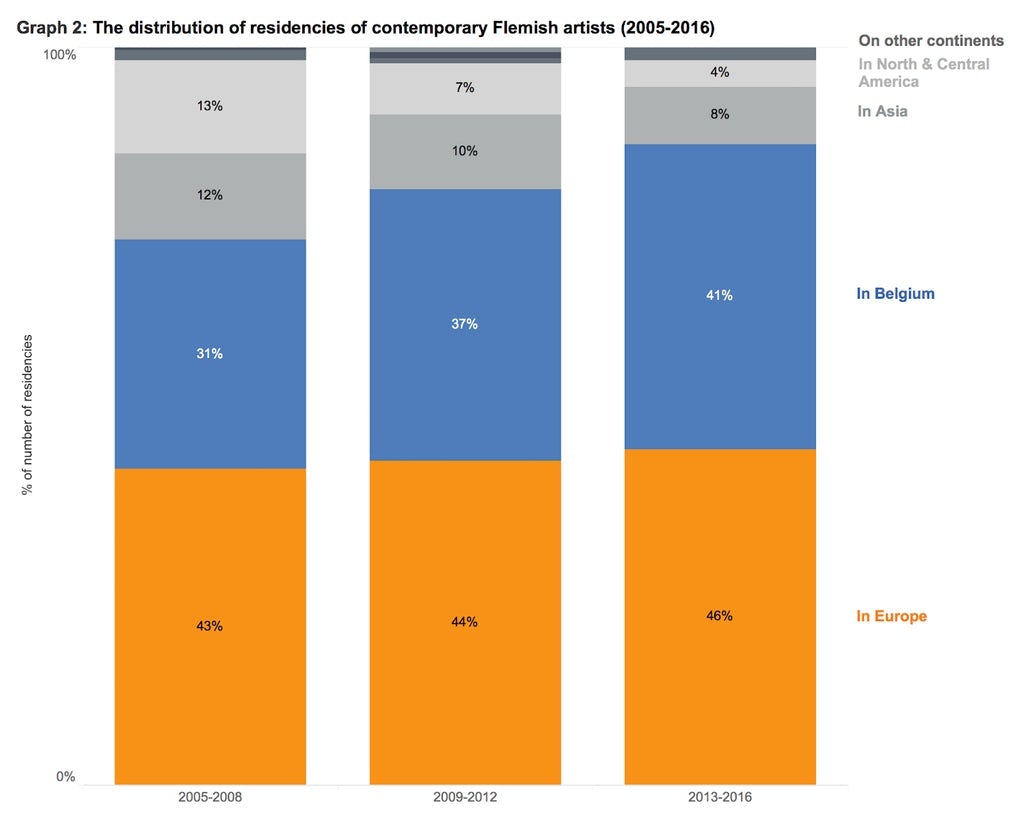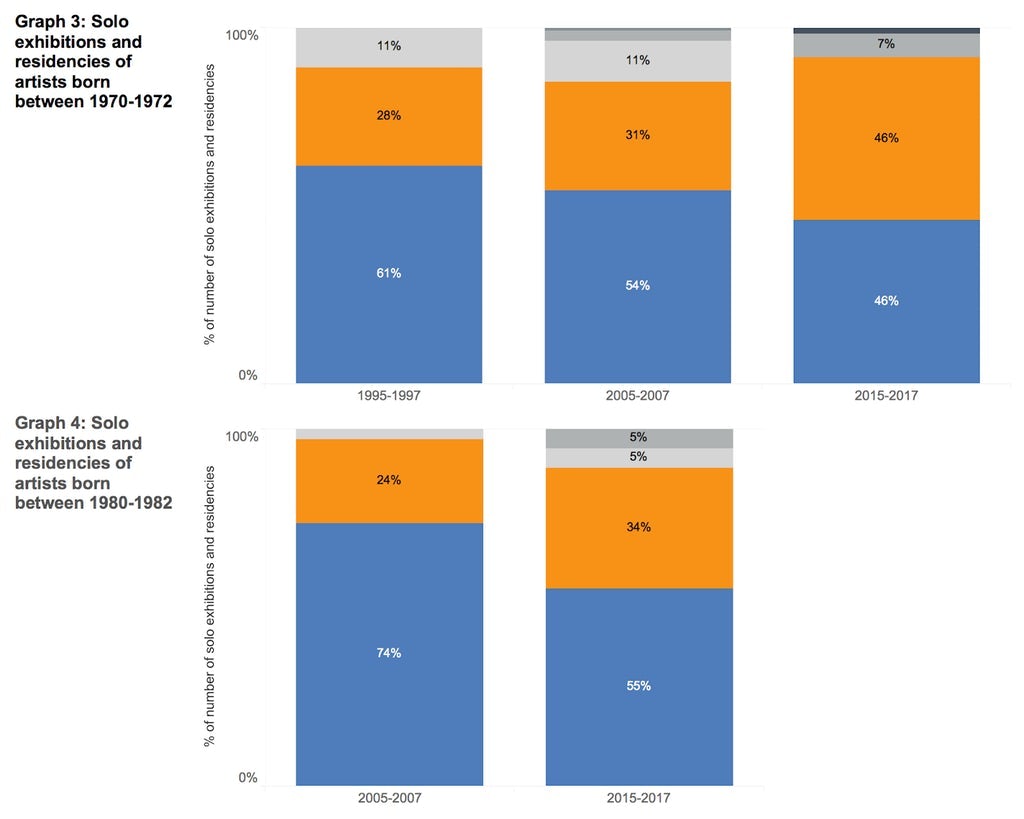
A Portrait of the Artist as a Traveller
(c) Annabella Schwagten

Globalisation and the visual arts: over the past decades, the subject has been covered in numerous exhibitions, symposia and publications. According to the narrative, ‘globalisation’ refers to a number of fundamental changes that the field of the visual arts would have undergone at the end of the twentieth and the beginning of the present century.
It is in this new context that ‘contemporary art’ is created, exhibited and traded in places where this was not the case before. The manner and scale at which art is made and the way in which communication and information flows take place in the art world have been radically altered by the emergence of new media and the internet. The international mobility of artists and curators has changed radically, partly due to changes in regulations on labour migration and the support mechanisms of national governments. At the same time, global flows of capital have emerged that influence the production, presentation and sale of art worldwide. With these changes, the roles of museums, biennials, art fairs and other cultural and commercial infrastructures have also evolved and been called into question. However, the views on how and to what extent the contemporary art world has been ‘globalised’ differ. (1)
Has the distribution of solo exhibitions and residencies by contemporary artists from Flanders and Brussels changed in recent years? If so, do we see traces of globalisation here or are there other factors at play?
This article, which is the harbinger of a more extensive study by Kunstenpunt/Flanders Arts Institute, elaborates on the theme of the mobility of artists and their work. More specifically, we will focus on the distribution of solo exhibitions and residencies of professional contemporary artists from Flanders and Brussels. A residency or the creation of a solo exhibition (usually) means that the artist in question travels to a certain place and stays there for a time. Both activities imply an engagement of the artist with a local art institution and, conversely, an engagement by the institution with the artist and his or her oeuvre. The distribution of the solo exhibitions and residencies gives a picture of the mobility of our contemporary artists and of the places where people are interested in going deeper into their work.
Has the distribution of solo exhibitions and residencies by contemporary artists from Flanders and Brussels changed in recent years? If so, do we see traces of globalisation here or are there other factors at play? Do artists exhibit more abroad than in the past? Does the same apply to artist residencies? Are more solo exhibitions and residencies occurring in places that do not belong to what is traditionally regarded as the ‘core’ of the contemporary art scene (especially Europe and North America)?
To answer these questions, we can make use of the online artists’ database of Kunstenpunt/Flanders Arts Institute.(2) Since 2005, this database has been collecting the CVs of hundreds of professional contemporary artists with a link to Flanders and Brussels. These data (about solo exhibitions and residencies, but also for example about works of art or education) are largely supplied by the artists themselves, so that we have a more complete picture of some careers than of others. While the database is still being supplemented in a targeted manner for the current research, in this article we will already venture a first exploration of the available data.

Graph 1 highlights the solo exhibitions between 2005 and 2016, the period for which we currently have the most data. The numbers of solo exhibitions are divided into four-year periods: in absolute figures, it concerns 1,521 solo exhibitions for 2005-2008, 1,613 for 2009-2012 and 1,410 for 2013-2016. Please note: the differences in absolute numbers do not necessarily indicate a decrease or increase in the number of solo exhibitions. There may be gaps in the data collection for certain years and this has an effect on the absolute numbers. For this reason and to facilitate the analysis of possible differences in the distribution of these exhibitions between these three periods, the numbers were converted to percentages. The share of solo exhibitions in Belgium is marked in blue. That of solo exhibitions in other European countries is orange and the share of such exhibitions on other continents is indicated in shades of grey.
If we compare the three bars, it is immediately obvious that there are few differences. The share of domestic solo exhibitions remains fairly stable (61%, 58% and 60% respectively in the three consecutive periods). In each of the three periods, a third of the total number of solo exhibitions took place in European countries other than Belgium. The underlying data tell us that these are mainly the Netherlands, Germany and France. The share of solo exhibitions in North and Central America (the lightest shade of grey) is between 4% and 5% (this largely concerns the United States). The share of such exhibitions in Asia (dark grey) fluctuates around 2% and 3%. Solo exhibitions in South America, Oceania and Africa (the darkest shades of grey) are each around 1% or less in the three periods.

Graph 2 shows the number of residencies between 2005 and 2016. In absolute numbers this concerns 215 residencies in 2005-2008, 264 in 2009-2012 and 167 in 2013-2016 (again, one has to be careful not to equate the differences in absolute figures with real increases or decreases in the number of residencies). In contrast to the solo exhibitions, the majority of residencies surveyed took place abroad. Residencies in European countries (orange) other than Belgium represent between 43% and 46% in the three periods. Again we read in the underlying data that this mainly concerns France, the Netherlands and Germany. The share of residencies in Belgium (blue) shows a different picture: it changes from 31% in 2005-2008 to 37% in 2009-2012 and even to 41% in 2013-2016. The shares of residencies in Asia and in North and Central America (marked in the lightest shade of grey) decrease throughout the period (from 12% to 8% and from 13% to 4% respectively). Residencies on other continents (the darkest shades of grey: Oceania, Africa, South America) tended to be the exception.
The picture we obtain from the two graphs is not consistent with thoroughgoing internationalisation. The distribution of the solo exhibitions of Flemish artists mainly takes place in Belgium. The foreign horizon is largely comprised of Europe and to a much lesser extent North and Central America. Solo exhibitions on other continents are rare. We also note little change in this situation between 2005 and 2016. While the Flemish artists mainly had residencies abroad during the period under review, we see here just the opposite of progressive internationalisation: the share of residencies in Belgium increased. The available Belgian residencies therefore grew between 2005 and 2016. We can see this in the underlying data. In addition to older organisations with a residency function (the Frans Masereel Centre or AIR Antwerp, for example), a number of new initiatives emerged during the course of this period, such as Wiels (since 2007), Overtoon (a subsidised operation with residencies since 2013) or the Emile Van Doren Museum (which has offered residency locations since 2010).
The findings about the activities of contemporary artists from Flanders and Brussels are in line with a number of studies that call into question the globalisation of the visual arts field.(3) Among these critical voices it can be said that the field is still dominated by actors from Western countries who have been at the centre of the contemporary arts field for a long time.(4) We also see this in the underlying data on the solo exhibitions and residencies: when these took place abroad, it was mainly in countries such as France, Germany and the United States. In between, we find the Netherlands, a country that, like Belgium, is further removed from that centre of global visual arts. Our neighbour, which traditionally has played an important role for the Flemish artistic and cultural field, remains a frequent destination for visual artists in the period under review.
In the last two graphs we zoom in on two groups of artists that are included in the Flanders Arts Institute database. Graph 3 shows the numbers of solo exhibitions and residencies (added together here) for contemporary artists who were in their mid-thirties during the first years in which the database was active (2005, 2006 and 2007). This concerns a total of 44 artists born between 1970 and 1972. Graph 4 shows the same numbers for 37 artists who are ten years younger: they were in their mid-30s in 2015, 2016 and 2017 (and born between 1980 and 1982). Based on informal knowledge of the field, this age (here defined as 33 to 37 years) is a turning point for many artists’ careers. In the database we also find mainly solo exhibitions and residencies that took place at the time when the artist in question was in his or her thirties. The latter might indicate a peak in the number of activities at this age. Some caution is recommended with this statement, because it is possible that we mainly received data from artists in their thirties, which could distort the picture.

Graphs 3 and 4 highlight a number of specific moments in the careers of these two groups of artists. Because we are limiting ourselves here to statements about the CVs of these artists, we can go further back in time than 2005 (at least for the artists who were born between 1970 and 1972). CVs often present a selection from the career of the artist, which influences the absolute number of exhibitions and residencies. For this reason, and again to make the comparison easier, everything was converted into percentages.
The data for the group born between 1970-1972 (Graph 3), are for the years 1995 to 1997 (when they were in their mid-twenties), 2005 to 2007 (when they were in their mid-thirties) and 2015-2017 (when they were in their mid-forties). If we look at the three periods from left to right, we see an increasing share of foreign solo exhibitions and residencies (activities in Belgium are again in blue, those in Europe in orange, and in shades of grey for the other continents). Especially the relative number of those in Europe increase. Also in Graph 4, depicting solo exhibitions and residencies of artists born between 1980 and 1982, we see that more foreign (mainly European) activities are reported on the CVs as they get older.
If we compare the two different groups of artists with each other, we see among those 23 to 27 years of age in 1995-1997 a smaller share (61%) of solo exhibitions and residencies in Belgium than among those 23 to 27 years of age in 2005-2007 (74%). The share of domestic activities among those 33 to 37 years of age in 2005-2007 and those in 2015-2017 is approximately the same (54% and 55% respectively). We note no major shifts in the international distribution of the solo exhibitions and residencies of those in their mid-30s, except for a smaller share of activities in North and Central America (11% in the group born in 1970-1972 and 5% in the group born in 1980-1982).
The picture given in Graphs 3 and 4 suggests that the number of international activities in both age groups is related to career development. The most striking difference in distribution between the age groups concerns not foreign countries, but Belgium. The Flemish arts field looked very different in 1995-1997 than in 2005-2007. A number of important exhibition and residency locations have been added such as the aforementioned Wiels (since 2007) and AIR Antwerp (since 2000), but also S.M.A.K. (since 1999), Be-Part (since 2005) and KIOSK (since 2006). Young artists who finished their studies around 2005-2007 had more opportunities to exhibit in Belgium or to do a residency than ten years earlier.
Investigation of the data from the artists’ database started from a number of questions about the distribution of solo exhibitions and residencies of contemporary Flemish artists and the possible impact of globalisation on this matter. The results so far suggest that the share of solo exhibitions and residencies abroad has not increased. There is also no question of a significant expansion of the distribution of these activities to regions that previously played no or only a peripheral role in the contemporary art scene. Changes in the professional arts field within Belgium, however, do emerge in the preliminary findings of the study. We see a larger share of domestic residencies than in the past, and the exhibition and residency opportunities for (young) Flemish artists have expanded compared to the nineties.
- See for example: Olav Velthuis and Stefano Baia Curioni, Cosmopolitan Canvases: The Globalization of Markets for Contemporary Art, 2015; Hans Belting, Andrea Buddensieg and Peter Weibel, The Global Contemporary and the Rise of New Art Worlds, 2013; Hans Belting and Andrea Buddensieg, The Global Art World, 2009; Charlotte Bydler, The Global Art World, Inc: On the Globalization of Contemporary Art, 2004.
- bamart.be/artists. To be included in the database, artists must meet a number of criteria. These can be found at bamart.be/pages/detail/nl/528
- A collection of critical papers can be found in the aforementioned volume Cosmopolitan Canvases: The Globalization of Markets for Contemporary Art (2015), edited by Olav Velthuis and Stefano Baia Curioni.
- See, for example, “The Impact of Nationality and Territory on Fame and Success in the Visual Arts Sector: Artists, Experts, and the Market” by Alain Quemin and Femke van Hest in Cosmopolitan Canvases (pp. 170-192).






